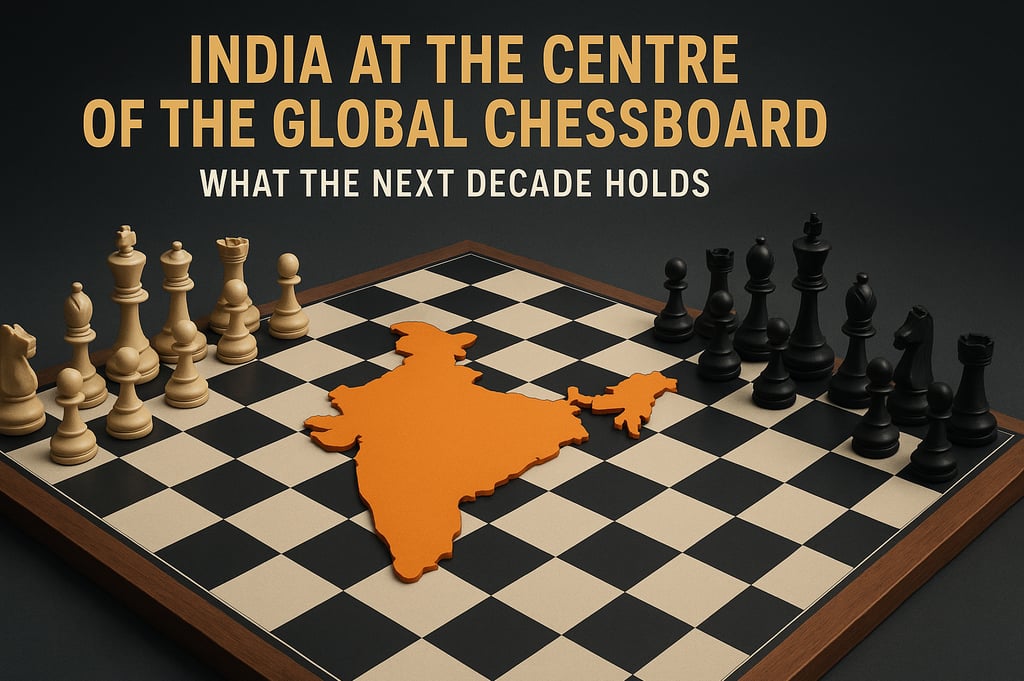✨ Global Indians Today – Where India Meets the World ✨
India at the Centre of the Global Chessboard: What the Next Decade Holds
8/20/20253 min read


The international system is undergoing a structural transformation. The post-Cold War unipolar moment led by the United States is gradually giving way to a multipolar order characterized by strategic competition among great powers. In this shifting landscape, India’s geographic location, demographic weight, and economic trajectory place it at the centre of global attention. Over the next decade, India’s choices in diplomacy, defence, and development will not only determine its national destiny but also shape the balance of power across Asia and beyond.
The world is changing fast. The days when the United States was the single, unquestioned global power are fading. Instead, we are moving towards a multipolar world, where influence is shared among several countries. And right in the middle of this power shift stands India—the world’s largest democracy, a rising economic force, and a country with unmatched cultural influence.
So, what does the next decade look like for India on the global chessboard? Let’s break it down.
Since independence, India has pursued a foreign policy anchored in non-alignment, resisting entanglement in power blocs during the Cold War. Post-1991 economic liberalization accelerated its integration into the global economy, while nuclear tests in 1998 and the subsequent U.S.-India civil nuclear deal (2005) signaled New Delhi’s growing strategic weight. Today, India describes its approach as strategic autonomy—cooperating with multiple partners without becoming subservient to any single power. This philosophy will continue to define India’s engagement with global politics in the coming decade.
India’s Geopolitical Positioning in 2025
In 2025, India is navigating a complex geopolitical landscape, balancing its rise as a global power with its strategic interests in a multipolar world. Key priorities embrace managing relationships with the US, China, and Russia, while also strengthening ties inside its South Asian neighbourhood. India's foreign policy continues to be defined by its multi-alignment strategy, engaging with various blocs and seeking to equilibrium its relationships with key powers.
1. Demographic Leverage – With over 1.4 billion people, India is the world’s most populous nation and possesses a demographic dividend unmatched by most aging economies.
2. Economic Ambitions – Currently the 5th largest economy, India aspires to become a $5 trillion economy within a few years, positioning itself as a critical node in global supply chains.
3. Strategic Geography – India’s control over the Indian Ocean sea lanes, which carry nearly 70% of global oil trade, makes it indispensable to maritime security.
4. Defence Modernization – Investments in indigenous defence production, space capabilities, and cyber warfare indicate India’s preparation for long-term strategic competition.
5. Soft Power Assets – From Ayurveda and Yoga to Bollywood and digital innovation, India’s cultural and technological influence adds a non-military dimension to its rise.
Key Challenges in the Decade Ahead
1. China’s Assertiveness – The border standoff in Ladakh since 2020 highlights the volatility of Sino-Indian ties. China’s Belt and Road Initiative (BRI) also seeks to encircle India strategically.
2. Pakistan Factor – While Pakistan’s economic fragility reduces its long-term threat, cross-border terrorism and regional instability remain persistent concerns.
3. Domestic Constraints – Infrastructure gaps, unemployment, and governance challenges could limit India’s ability to project power abroad.
4. Global Economic Uncertainty – Supply chain disruptions, protectionism, and energy crises may test India’s resilience.
5. Technological Dependence – Despite being an IT powerhouse, India still relies heavily on external partners for critical technologies like semiconductors and advanced weaponry.
Strategic Opportunities for India
1. Indo-Pacific Leadership – Through initiatives such as the Quad (India, U.S., Japan, Australia), India can shape a free, open, and rules-based maritime order.
2. Middle Power Coalitions – Partnerships with France, the UAE, ASEAN, and Africa provide India space to diversify strategic linkages.
3. Global Governance – India’s G20 presidency in 2023 showcased its potential to influence multilateral agendas on climate change, digital governance, and global finance.
4. Technology Partnerships – Collaboration with the U.S. and Europe on AI, space, and defence tech could position India as a hub of innovation.
5. Energy Security & Green Transition – Investments in renewable energy and hydrogen could reduce dependence on fossil fuel imports while enhancing India’s leadership in climate diplomacy.
Scenarios for the Next Decade
Optimistic Scenario: India achieves sustained economic growth above 7%, successfully leverages supply chain diversification away from China, modernizes its military, and consolidates its leadership in the Global South. By 2035, it emerges as a credible pole in the multipolar order.
Baseline Scenario: India continues gradual growth with periodic internal and external challenges. It balances partnerships with the U.S., Russia, and regional actors while avoiding entanglement in military conflicts. India becomes a key “balancing power” but not yet a global superpower.
Pessimistic Scenario: Domestic economic slowdown, persistent unemployment, and internal political turbulence weaken India’s capacity to project power. China consolidates dominance in Asia, and India’s influence is reduced to subregional affairs.
India’s geopolitical trajectory is neither predetermined nor linear. Its ability to navigate great power rivalry, secure its borders, and sustain high economic growth will decide whether it becomes a global power or remains a balancing actor in a multipolar world. What is certain is that in the next decade, no conversation about the future of international order will be complete without India at the table.
